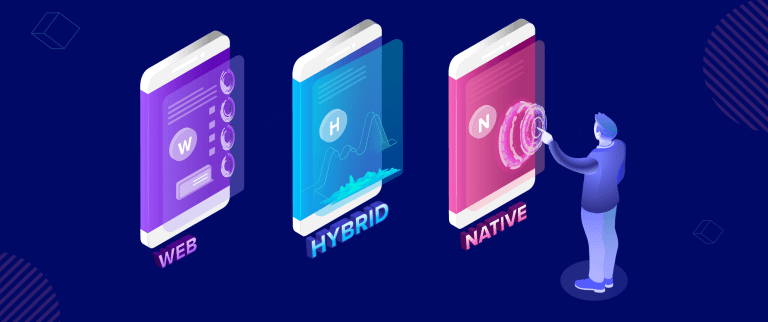
Shivkumar M Shivkumar M has over 20 years of experience shaping technology product and GTM strategy. With B2B SaaS expertise across industries, he leads product launches, adoption, and GTM as Director of Product Marketing.

Industry Best Practices & Top Insights delivered to your Inbox.
Anyone planning to build an app for their business will inevitably have to answer the question: which type of mobile app do we build? You may read about other brands who tout how they built their native app from the ground up, or find out a company has a web app or a hybrid app. But what do those terms mean exactly? We hope to introduce you to the differences between the three types, and along the way, discuss the advantages and disadvantages of each so you can arrive at an informed decision.
There are three basic types of mobile apps if we categorize them by the technology used to code them:
Native apps are built specifically for a mobile device’s operating system (OS). Thus, you can have native Android mobile apps or native iOS apps, not to mention all the other platforms and devices. Because they’re built for just one platform, you cannot mix and match – say, use a Blackberry app on an Android phone or use an iOS app on a Windows phone.
Technology Used: Native apps are coded using a variety of programming languages. Some examples include: Java, Kotlin, Python, Swift, Objective-C, C++, and React.
Pros: Because of their singular focus, native apps have the advantage of being faster and more reliable in terms of performance. They’re generally more efficient with the device’s resources than other types of mobile apps. Native apps utilize the native device UI, giving users a more optimized customer experience.
And because native apps connect with the device’s hardware directly, they have access to a broad choice of device features like Bluetooth, phonebook contacts, camera roll, NFC, and more.
Cons: However, the problem with native apps lies in the fact that if you start developing them, you have to duplicate efforts for each of the different platforms. The code you create for one platform cannot be reused on another. This drives up costs. Not to mention the effort needed to maintain and update the codebase for each version.
And then, every time there’s an update to the app, the user has to download the new file and reinstall it. This also means that native apps do take up precious space in the device’s storage.
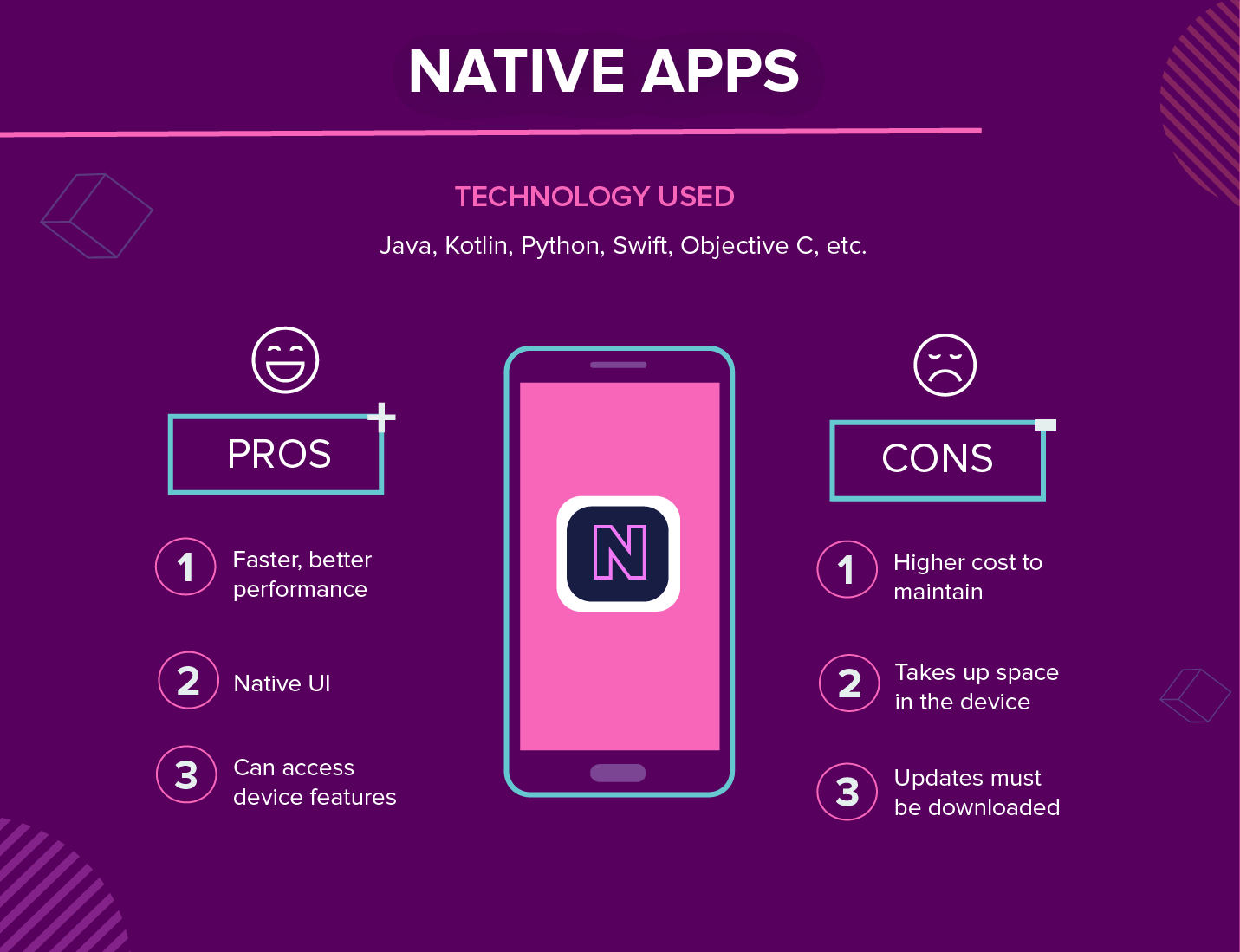
Web apps behave similarly to native apps but are accessed via a web browser on your mobile device. They’re not standalone apps in the sense of having to download and install code into your device. They’re actually responsive websites that adapt its user interface to the device the user is on. In fact, when you come across the option to “install” a web app, it often simply bookmarks the website URL on your device.
One kind of web app is the progressive web app (PWA), which is basically a native app running inside a browser.
Technology Used: Web apps are designed using HTML5, CSS, JavaScript, Ruby, and similar programming languages used for web work.
Pros: Because it’s web-based, there is no need to customize to a platform or OS. This cuts down on development costs.
Plus, there’s nothing to download. They won’t take up space on your device memory like a native app, making maintenance easier – just push the update live over the web. Users don’t need to download the update at the app store.
Cons: But this is also pertinent: web apps are entirely dependent on the browser used on the device. There will be functionalities available within one browser and not available on another, possibly giving users varying experiences.
And because they’re shells for websites, they won’t completely work offline. Even if they have an offline mode, the device will still need an internet connection to back up the data on your device, offer up any new data, or refresh what’s on screen.
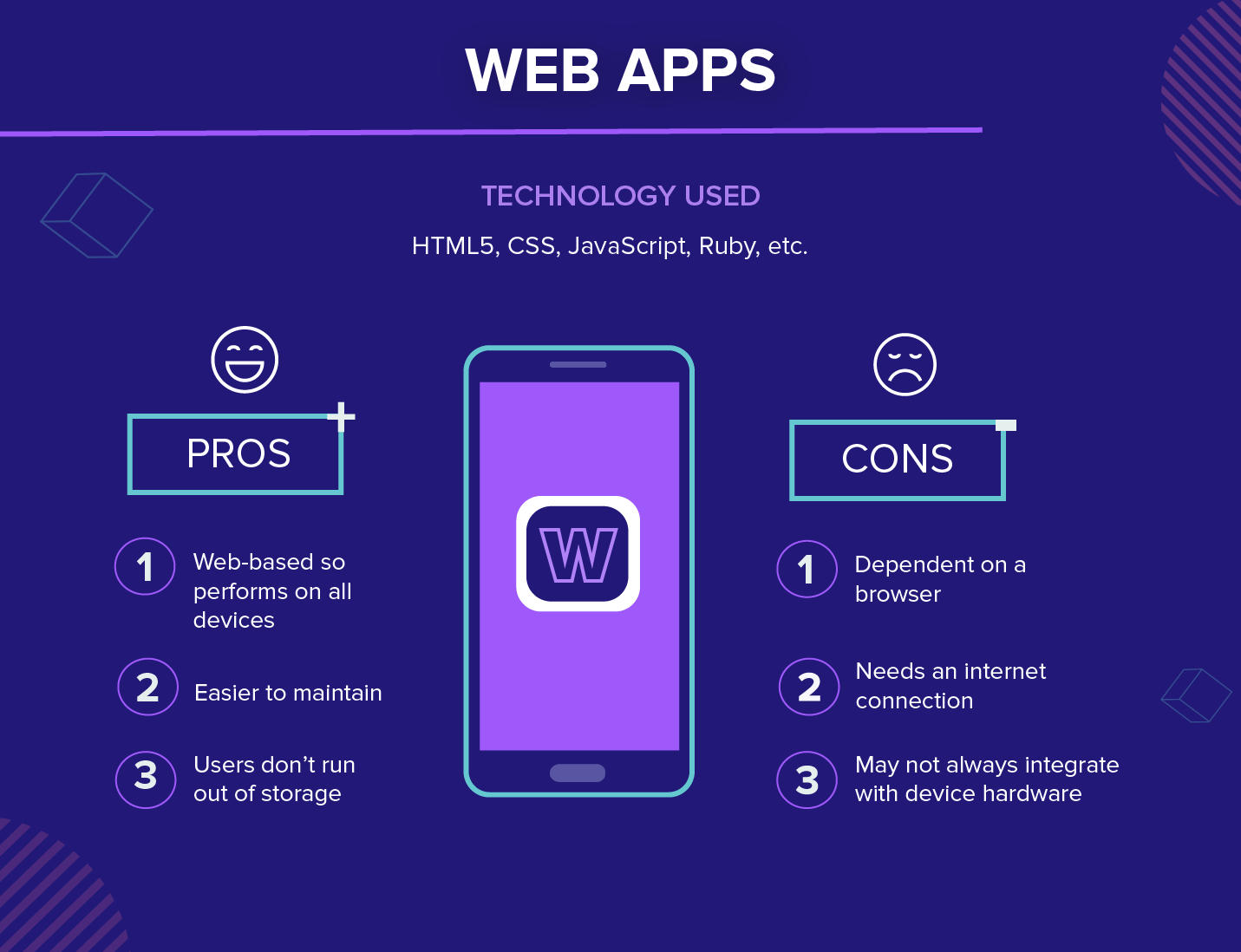
And then there are the hybrid apps. These are web apps that look and feel like native apps. They might have a home screen app icon, responsive design, fast performance, even be able to function offline, but they’re really web apps made to look native.
Technology Used: Hybrid apps use a mixture of web technologies and native APIs. They’re developed using: Ionic, Objective C, Swift, HTML5, and others.
Pros: Building a hybrid app is much quicker and more economical than a native app. As such, a hybrid app can be the minimum viable product – a way to prove the viability of building a native app. They also load rapidly, are ideal for usage in countries with slower internet connections, and give users a consistent user experience. Finally, because they use a single code base, there is much less code to maintain.
Cons: Hybrid apps might lack in power and speed, which are hallmarks of native apps.
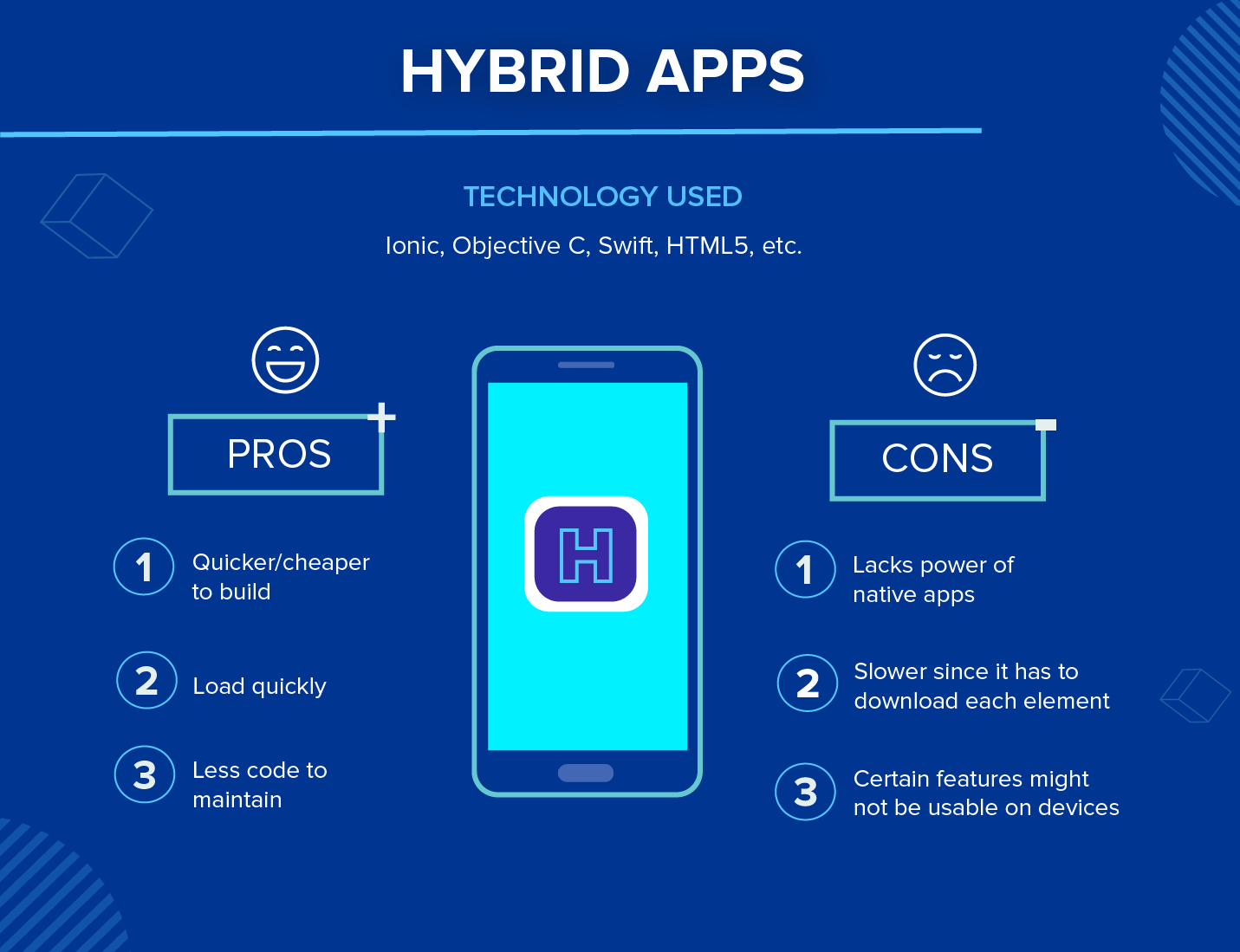
If you’re currently developing an app, then you need to make a decision about which type of app you’re going to be creating. There will be certain factors that are ideal only on one type of app, and not on others.
As you go through the following decision factors, you should answer: what is the single most important factor for your decision today? The answer will dictate which type you have to focus on NOW.
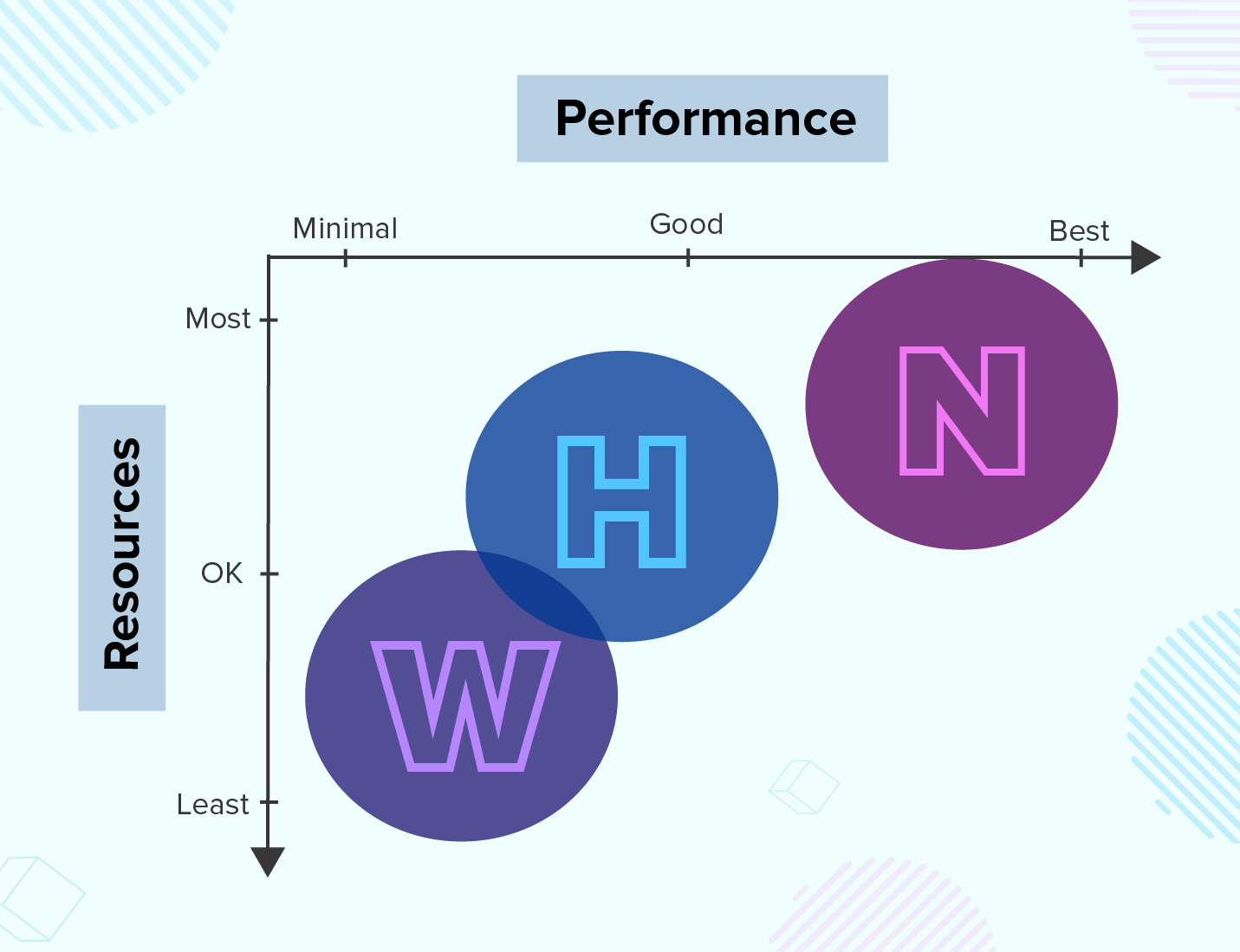
If you absolutely must have an app in the shortest amount of time possible, then you need to invest in building a web app. Not only will one codebase drastically speed up development time, but it will also mean that your users already have what they need to use it: a mobile browser.
If time and money are not on your side, then consider either a web app or a hybrid app. The hybrid app gives you a chance to test the market with a minimum viable product that can be in the hands of users within a few months. And if successful, you can decide to build a full-fledged native version later on.
If performance is of the utmost importance, then there’s no way around it: you need to develop a native app. This type of app will give you the speed, stability, and customization features you deem crucial to your success. In the end, choosing which type of mobile app you will build is not a one-and-done decision. You can always choose to build another type down the road, depending on your user’s needs. And once you do finally build it, make sure you monitor the metrics that matter for the actual growth of your brand.